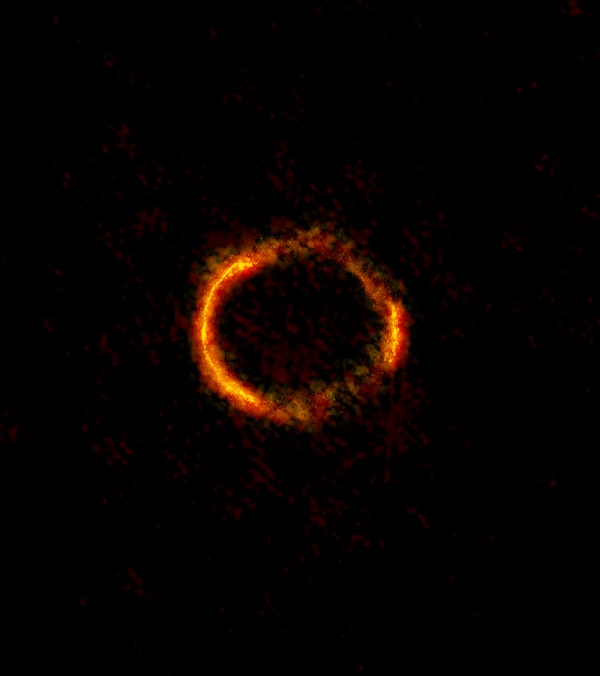Amazing Einstein Ring 'Eye of Sauron' Ancient Galaxy Captured by ALMA
| Ana Verayo | | Apr 08, 2015 03:53 AM EDT |
(Photo : ALMA (NRAO/ESO/NAOJ); B. Saxton NRAO/AUI/NSF) ALMA image of the gravitationally lensed galaxy SDP.81. The bright orange central region of the ring reveals the glowing dust in this distant galaxy. The surrounding lower-resolution portions of the ring trace the millimeter wavelength light emitted by carbon monoxide.
A distant galaxy with an Einstein ring spotted by astronomers is considered one of the most stunning examples of this phenomenon seen using the most powerful ground based observatory in the world.
The Atacama Large Millimeter/submillimeter Array (ALMA) telescope is located in Chile's Atacama desert and its antennae are about 15 kilometers apart to detect even more distant objects. ALMA has now gone online enabling astronomers to realize its full potential.
Like Us on Facebook
This ancient galaxy called the SDP.81 was observed during ALMA's Long Baseline Campaign executed at the end of 2014
SDP.81 is warped by a massive foreground galaxy and is slightly bent around a warped spacetime. Scientists estimate this ancient galaxy began forming when the Universe was just 15 percent of its age today.
This warping is caused by gravitational lenses first observed by the Hubble space telescope. This phenomenon is produced when any source of light become warped around massive objects, especially in galaxy clusters.
Bright arcs are often observed and these can transform into circles that can create amazing Einstein rings.
In Hubble's survey project called "Frontier Fields", distant galaxy lights formed in arcs were pieced back together to get a better view of these stellar formations.
This almost perfect ring comparable to the Lord of the Ring's depiction of the "Eye of Sauron" wasn't captured by Hubble but ALMA revealed a high resolution image of the ring that shows never before seen details of the young galaxy.
ALMA possesses long-baseline interferometers in every single antennae that can be spaced in great distances, simulating a satellite dish 15 kilometers wide. This configuration can boost ALMA's observational powers so it can acquire better images and data than Hubble.
TagsALMA observatory, einstein ring ancient galaxy ALMA, einstein ring, Amazing Einstein Ring 'Eye of Sauron' Ancient Galaxy Captured by ALMA
©2015 Chinatopix All rights reserved. Do not reproduce without permission
EDITOR'S PICKS
-

Did the Trump administration just announce plans for a trade war with ‘hostile’ China and Russia?
-

US Senate passes Taiwan travel bill slammed by China
-

As Yan Sihong’s family grieves, here are other Chinese students who went missing abroad. Some have never been found
-

Beijing blasts Western critics who ‘smear China’ with the term sharp power
-

China Envoy Seeks to Defuse Tensions With U.S. as a Trade War Brews
-

Singapore's Deputy PM Provides Bitcoin Vote of Confidence Amid China's Blanket Bans
-

China warns investors over risks in overseas virtual currency trading
-

Chinese government most trustworthy: survey
-

Kashima Antlers On Course For Back-To-Back Titles
MOST POPULAR
LATEST NEWS
Zhou Yongkang: China's Former Security Chief Sentenced to Life in Prison

China's former Chief of the Ministry of Public Security, Zhou Yongkang, has been given a life sentence after he was found guilty of abusing his office, bribery and deliberately ... Full Article
TRENDING STORY

China Pork Prices Expected to Stabilize As The Supplies Recover

Elephone P9000 Smartphone is now on Sale on Amazon India

There's a Big Chance Cliffhangers Won't Still Be Resolved When Grey's Anatomy Season 13 Returns

Supreme Court Ruled on Samsung vs Apple Dispute for Patent Infringement

Microsoft Surface Pro 5 Rumors and Release Date: What is the Latest?










